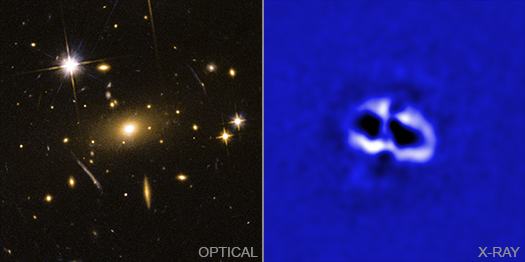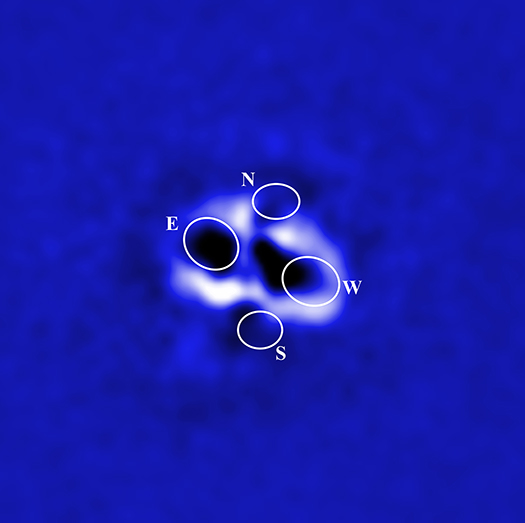Astronomers Spy Quartet of Cavities From Giant Black Holes

Galaxy Cluster RBS 797
Credit: X-ray: NASA/CXC/Univ. of Bologna/F. Ubertosi; Optical: NASA/STScl/M.Calzadilla
Four enormous cavities, or bubbles, have been found at the center of a galaxy cluster using NASA's Chandra X-ray Observatory, as described in our latest press release. The left panel of this graphic shows an optical image of the galaxy cluster called RBS 797, from NASA's Hubble Space Telescope. Hot gas that envelopes the individual galaxies is invisible in optical light, but it is detected in X-rays by Chandra (right). One pair of cavities can be seen towards the left and right of center in the Chandra image as black oval-shaped regions. The other pair is less distinct, but can be found above and below the center of the image.
Scientists have seen these X-ray cavities before in other galaxy clusters. A pair of cavities is thought to be a byproduct of eruptions from a giant black hole in a large galaxy at the center of a cluster. The eruptions power jets in opposite directions, which push gas away to create a pair of cavities. However, to produce four cavities each roughly pointing 90 degrees away from one another, a more complex phenomenon must be at play.
A team of astronomers studying RBS 797 think the most likely answer is that the galaxy cluster contains a pair of supermassive black holes, each of which has launched jets in perpendicular directions at almost the same time. Another possible explanation for the four cavities seen in RBS 797 is that there is only one supermassive black hole — with jets that somehow manage to flip around in direction quite quickly. Analysis of the Chandra data shows that the age difference for the east-west and north-south cavities is less than 10 million years.
Previously, astronomers observed the pair of cavities in the east-west direction in RBS 797, but the pair in the north-south direction was only detected in a new, much longer Chandra observation. The deeper image uses almost five days of Chandra observing time, compared to about 14 hours for the original observation. The NSF's Karl G. Jansky Very Large Array had already observed evidence for two pairs of jets as radio emission, which line up with the cavities.
A paper describing these results, led by Francesco Ubertosi (University of Bologna in Italy) appears in The Astrophysical Journal Letters as is available online: https://arxiv.org/abs/2111.03679 The other authors include Myriam Gitti (Univ. of Bologna), Fabrizio Brighenti (Univ. of Bologna), Gianfranco Brunetti (INAF), Michael McDonald (Massachusetts Insitute of Technology), Paul Nulsen (Center for Astrophysics | Harvard & Smithsonian), Brian McNamara (Perimeter Institute), Scott Randall (CfA), William Forman (CfA), Megan Donahue (Michigan State University), Alessandro Ignesti (INAF), Massimo Gaspari (INAF), Steffano Ettori (INAF), Luigina Feretti (INAF), Elizabeth L. Blanton (Boston University), Christine Jones (CfA), and Michael S. Calzadilla (MIT).
Please note this is a moderated blog. No pornography, spam, profanity or discriminatory remarks are allowed. No personal attacks are allowed. Users should stay on topic to keep it relevant for the readers.
Read the privacy statement

